Seasons
Earth experiences astronomical seasons due to its obliquity, As with diurnal heating, a region’s seasons depend on a variety of reasons, such as proximity to the ocean, the temperature of the nearby ocean current, elevation, amount of vegetation landcover, etc.. Still, we must start by examing the patterns of solar illumination throughout the year.
Distribution of Daylight Throughout the Year
Every location on Earth experiences an average of 12 hours of daylight a day during a year. Looking at declination circles for the different latitudes for June 21 (solstice), March 21 (Equinox), and December 21 (solstice), the hours of daylight may change dramatically during a year.
Variability of Sun Angle Throughout the Year
Every location on Earth experiences the same solar declination throughout the year: +23.5º to -23.5º. But how the local noon Sun angle changes throughout the year may be quite different between locations. Examine the declination circles for the different latitudes for June 21 (solstice), March 21 (Equinox), and December 21 (solstice) and analyze how local noon Sun angle changes annually.
Seasons: Intensity and Amount of Sunlight
How much sunlight and how intense it is during an astronomical season are the primary drivers for creating the temperature of the region’s season. If a region experiences no or little sunlight, expect a bitterly cold season. If the local noon sun is consistently high in the sky during a season, expect it to be hot. If the amount of sunlight or its intensity changes substantially during a season, then the temperature should change rapidly.
Decide how warm, mild, cold, or variable the seasons are for the following series of declination circles.
Plants respond to the seasons, with the greening of spring supporting the emergence of dormant animals and the migration of animals back to the region. This timelapse movie of a maple tree in eastern Massachusetts (~42°N) in May shows how the tree responds to the longer hours of sunlight, warmer temperatures, wind, and rain.
In the movie, how is the Sun's path changing each day?
If you place your finger on the Sun’s position during a given frame, each day, the Sun moves to the left. Since the Sun is increasing in elevation, we are looking at the Sun’s motion during the morning hours, so we are looking in an eastward direction. North must be to the left, so each day, the Sun’s path is shifting northward.
Equator
December 21
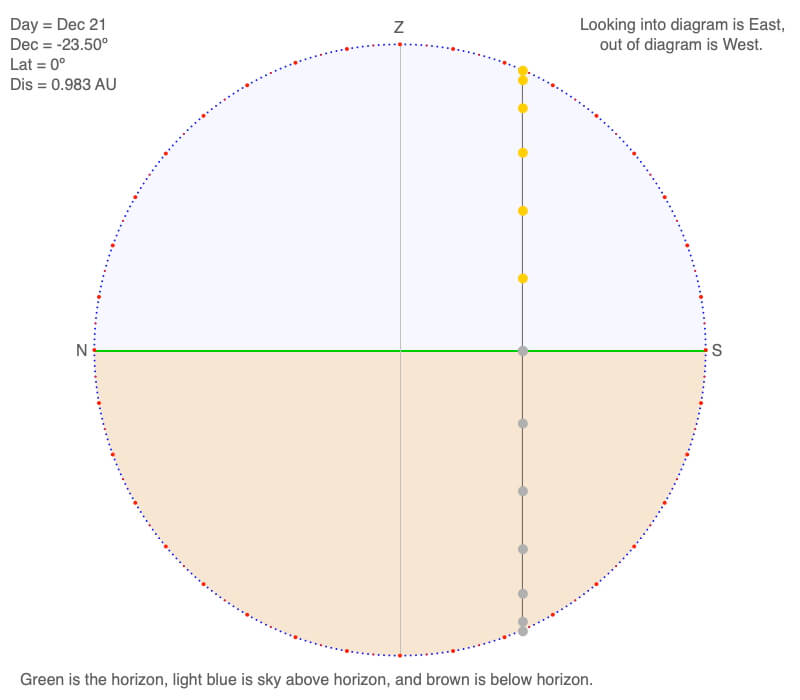
Hours of Daylight?
12 hours.
Local Noon Sun Angle?
66.5º above the horizon.
Seasonal Temperature?
Very warm to hot.
March 21
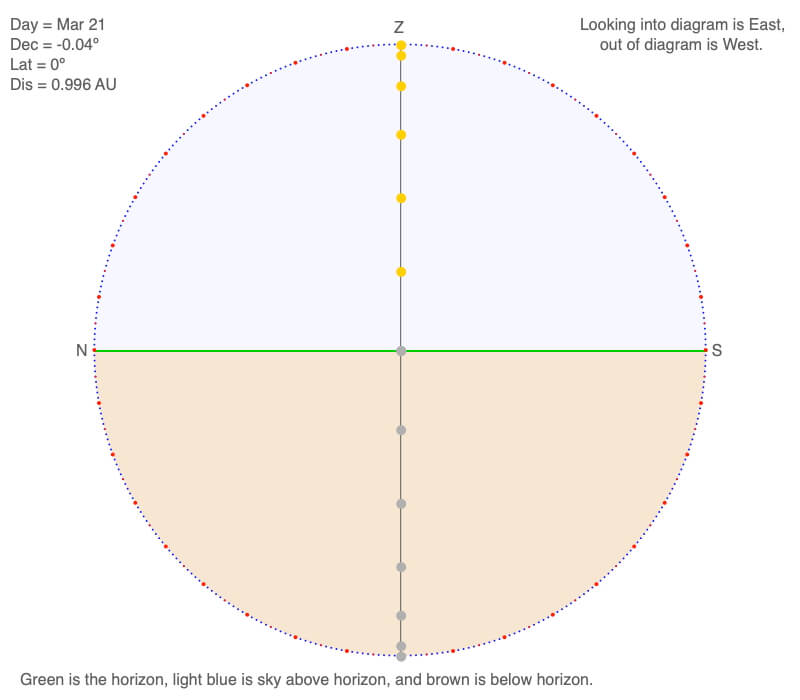
Hours of Daylight?
12 hours.
Local Noon Sun Angle?
90º above the horizon or directly overhead.
Seasonal Temperature?
Hot.
June 21
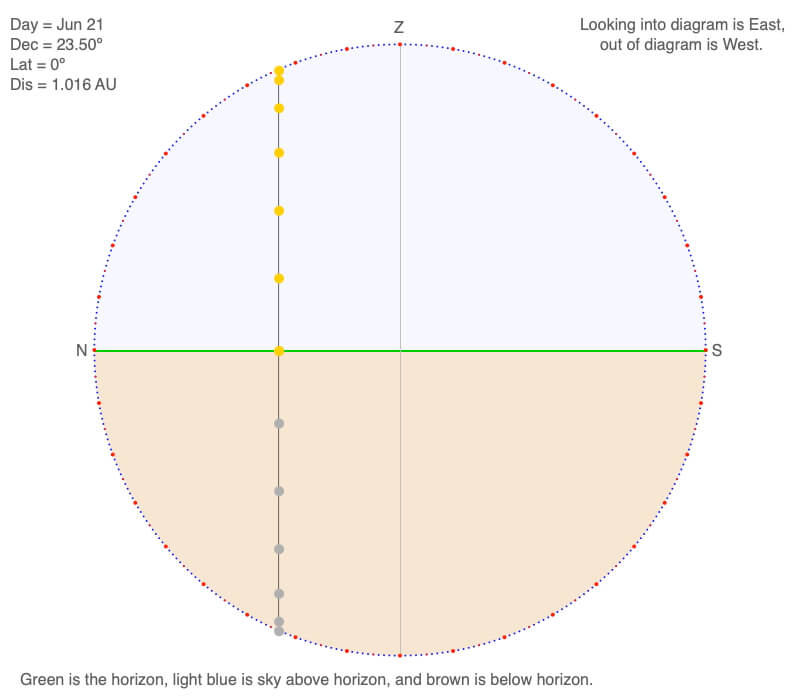
Hours of Daylight?
12 hours.
Local Noon Sun Angle?
66.5º above the horizon.
Seasonal Temperature?
Very warm to hot.
45ºN
December 21
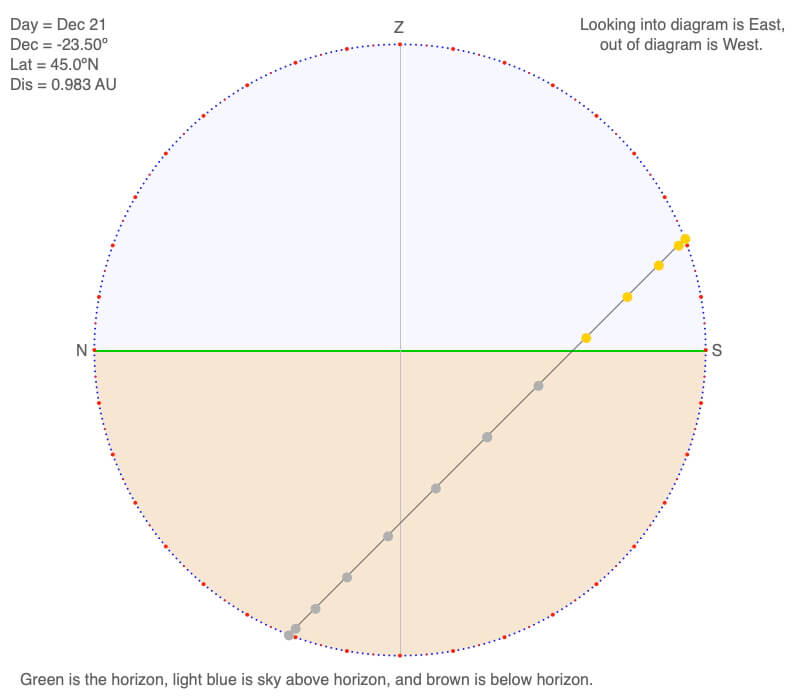
Hours of Daylight?
Estimate the time of sunrise and sunset from the hour positions (the orange and gray circles on the declination circle).
Sunrise ~ 7:45 AM
Sunset ~ 4:15 PM
There are 8.5 hours of daylight between the estimates times for sunrise and sunset.
The actual is 8.6 hours.
Local Noon Sun Angle?
21.5º above the horizon.
Seasonal Temperature?
There are fewer hours of daylight and the Sun is low in the sky.
Expect it to be cold.
March 21
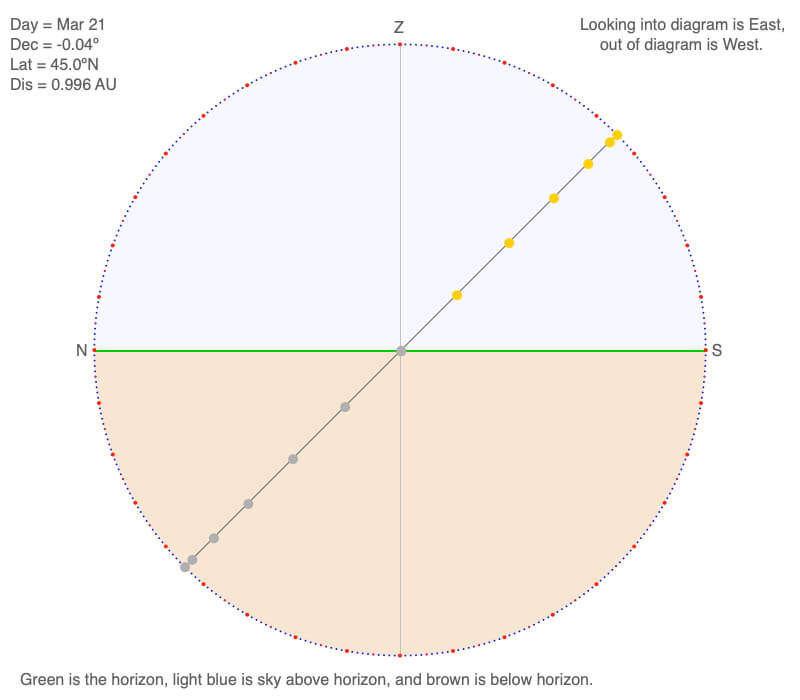
Hours of Daylight?
12 hours.
Local Noon Sun Angle?
45º above the horizon.
Seasonal Temperature?
The beam concentration for a Sun 45º above the horizon is 0.71. The area is heated moderately.
During the March 21 equinox, the area is transitioning from winter to summer, and temperatures will begin to warm faster and faster during the next three months.
During the September 22 equinox, the temperatures will begin to fall faster and faster as it transitions to autumn.
June 21
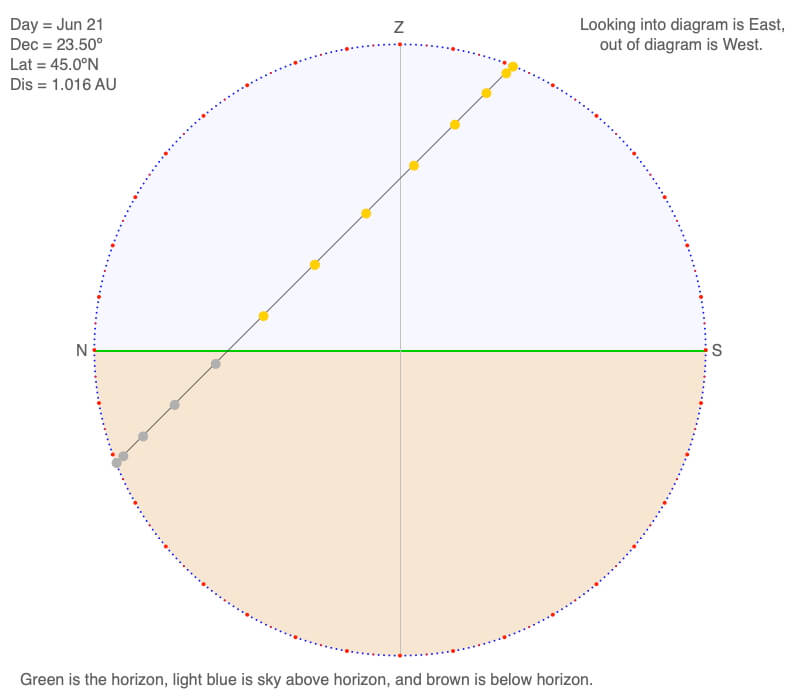
Hours of Daylight?
Estimate the time of sunrise and sunset from the hour positions (the orange and gray circles on the declination circle).
Sunrise ~ 4:15 AM
Sunset ~ 7:45 PM
There are 15.5 hours of daylight between the estimates times for sunrise and sunset.
The actual is 15.4 hours.
Local Noon Sun Angle?
68.5º above the horizon.
Seasonal Temperature?
The Sun is higher in the sky than for the Equator at this time of year, and there is more hours of daylight.
Expect it to be very warm to hot.
North Pole (90ºN)
December 21
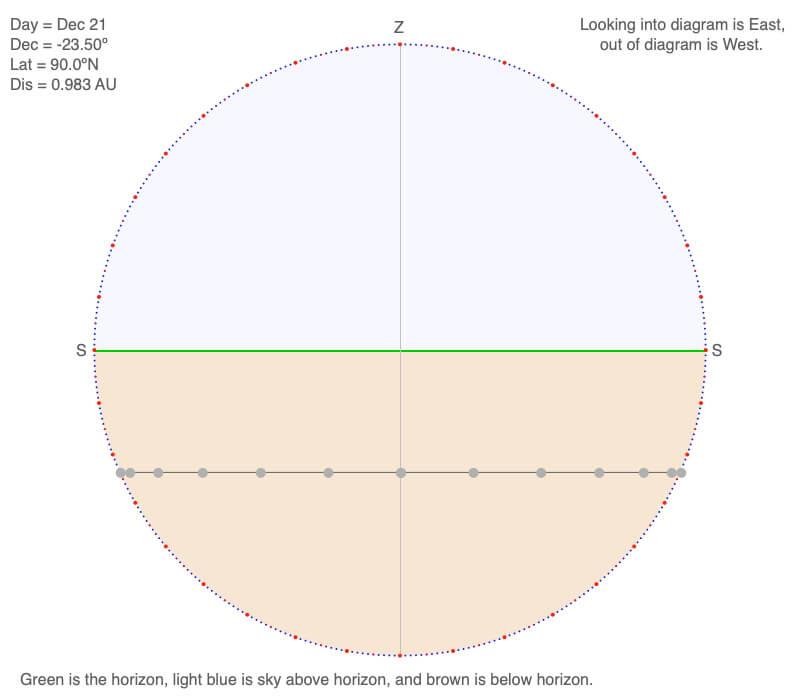
Hours of Daylight?
0 hours. The Sun has been below the horizon for three months, and it has another three months before it rises above the horizon.
Local Noon Sun Angle?
23.5º below the horizon.
Seasonal Temperature?
Having been dark for three continuous months, it will be frigid.
March 21
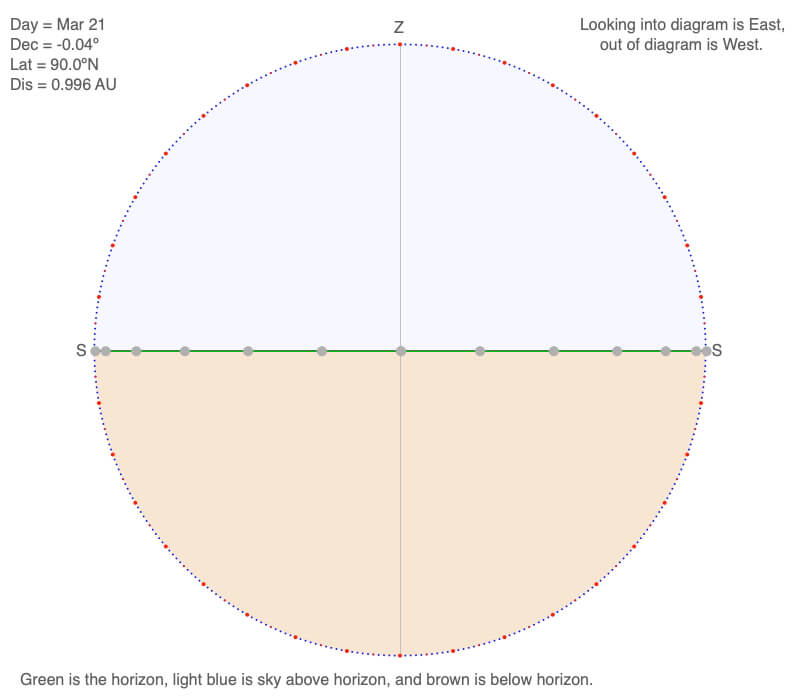
Hours of Daylight?
This day is a new situation – 24 hours of sunrise on March 21. The sun stays in the horizon all day as it slowly makes a complete circle around you.
This scenario would also happen on September 21, although it would be 24 hours of sunset.
Local Noon Sun Angle?
0º above the horizon all day.
Seasonal Temperature?
During the March 21 equinox, the region is transitioning from winter to summer conditions. The area will warm more slowly if there are snow and ice present since these are reflective surfaces. Also, it takes time to heat the cold surfaces. But temperatures will be changing continuously during the next three months.
During the September 22 equinox, the Sun is setting, and it will be dark for the next six months. Any object that is still warm will cool off rapidly due to the emission of thermal radiation. An object emits thermal radiation proportional to its temperature to the fourth power! Temperatures will transition quickly during this time of the year.
June 21
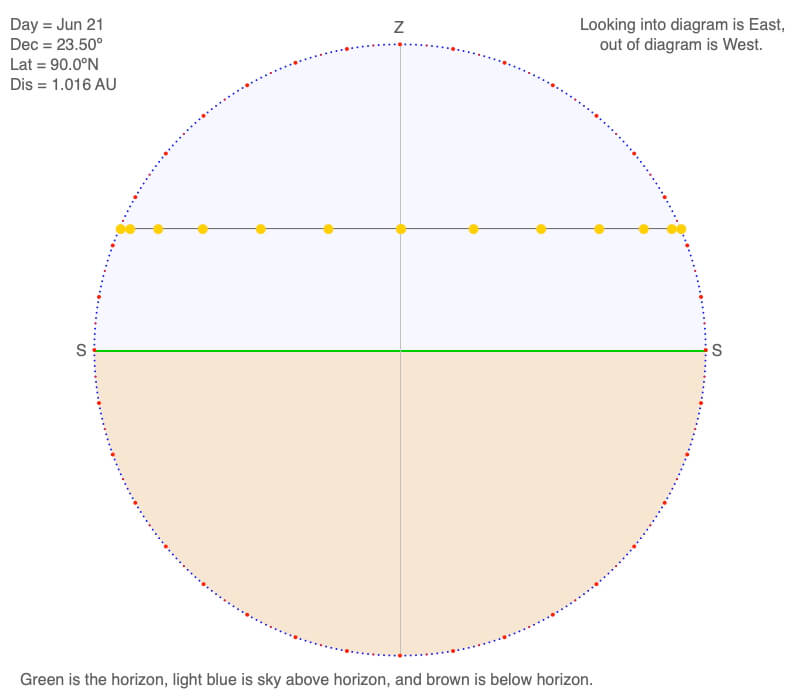
Hours of Daylight?
24 hours.
Local Noon Sun Angle?
Technically local noon doesn’t exist at the North Pole since the since stays the same angle above the horizon all day. Also, all longitudes meet at the poles, so the Sun is continuously crossing a longitude line (another criterion for local noon).
Although not the local noon Sun angle, the Sun is 23.5º above the horizon all day.
Seasonal Temperature?
The pole has been experiencing three months of daylight up to this point, although it has been relatively low in the sky. The Sun will remain above the horizon for another three months.
It is surprising to think about six months of daylight. When the Sun is 20%, the beam spread is 2.92, and the intensity of sunlight on a unit square piece is ground is 34% compared to when the Sun is directly overhead, having extended periods of daylight adds up. The North Pole receives more sunlight during a day compared to the Equator during an equinox!
But if covered by snow and ice, which reflect most of the incoming sunlight, the Pole stays cool. But if it melts, the exposed ground will warm considerably.
So this period is cold if snow and ice are present. Much warmer if the ground is exposed.
Southern Hemisphere
As seen in the Obqluity and Earth’s Illumination, the solar heating of the Southern Hemisphere is quite similar to the Northern Hemisphere, just shifted by half a year. June 21 is the Southern Hemisphere’s winter solstice; whereas, December 21 is the Northern Hemisphere’s beginning of winter.
Continue Exploring Seasons for Other Latitudes
Use the desktop app, Sun-Earth Connection, to explore the illumination patterns at other latitudes. Download Mac or PC versions at the Software page.
Big Ideas
- Earth experiences astronomical seasons due to its obliquity.
- How much sunlight and how intense it is during an astronomical season are the primary drivers for creating the region’s season temperature.
- For a given location, latitude and obliquity determine how daylight hours and the local noon Sun angle change throughout the year.
Click on the following toggles to view descriptions and links of the web pages on each topic of the Sun-Earth Connection.
Sun-Earth Connection overview
An overview of how the Sun’s energy is generated and how its thermal radiation illuminates and heats Earth.
Earth Illumination Patterns
- Overview: The Sun illuminates the spherical, rotating planets orbiting it.
- Obliquity and Earth’s Illumination: Obliquity is the angle between the planes of the Earth’s equator and its orbit around the Sun.
- Declination, Latitude, & Earth Illumination: Solar declination is the angle between the Sun’s rays and the plane of the Earth’s Equator. Its value depends on where Earth is in its orbit around the Sun.
- Astronomical Seasons & Illumination: Astronomical seasons are based on the orientation of Earth’s axis of rotation to the Sun, which determines the amount of illumination between the Northern and Southern Hemispheres.
Distribution of the Sun's Energy on Earth
- Overview: Even though an area is illuminated by sunlight, there can be quite a range of energy interacting with the surface.
- Sun Angle and Beam Concentration: If every beam of sunlight reaching Earth has the same amount of energy, why do some areas warm up more than others?
- Diurnal Heating: Diurnal heating is the temperature change over 24 hours. When sunlight shines on the ground, it warms. Two critical factors that determine the amount of heating deal with the Sun’s illumination.
- Seasons: Earth experiences astronomical seasons due to its obliquity.
- Climate Regimes: Climate regimes are an extension of diurnal heating and seasons, but the time frame is now years.
Declination Circles: A tool to analyze the Sun's position in the sky.
- Overview: Drawings of declination circles contain the visual and numerical information to understand and predict the Sun’s motion across the sky.
- Declination Circles 101: Draw a declination circle with just a ruler and protractor/compass to quickly and accurately know the Sun’s position in the sky at any day and time of the year for any location on Earth.
- Drawing Declination Circles: Declination circles are quite easy to draw by hand.
- Interpreting Time on Declination Circles: Accurately estimate the time of day using the Sun’s location in the sky.
- Sunrise, Sunset, & Twilight: Calculate the timing and duration when the Sun is at or near the horizon.
- Solar Time, Angle, & Position: The sun’s angle and direction to the local horizon define the Sun’s position in the local sky. Explore how to use declination circles to calculate the Sun’s position at any solar time anywhere in the world on any day of the year.
- Changing Views of Declination Circles: Use the web app View Declination Circles to explore three common views of declination circles to identify their strengths, limitations, and applications. Then learn how to go from one view to another.
- Using Declination Circles: Humans have been using the apparent motion of the Sun as a compass, clock, and calendar for millennia.
- Using Sundials: Humans have been using the Sun’s position to navigate and tell the time, day, and season for millennia. Sundials create shadows that make it easier to do these tasks.

0 Comments